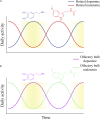Illuminating and Sniffing Out the Neuromodulatory Roles of Dopamine in the Retina and Olfactory Bulb
- PMID: 33110404
- PMCID: PMC7488387
- DOI: 10.3389/fncel.2020.00275
Illuminating and Sniffing Out the Neuromodulatory Roles of Dopamine in the Retina and Olfactory Bulb
Abstract
In the central nervous system, dopamine is well-known as the neuromodulator that is involved with regulating reward, addiction, motivation, and fine motor control. Yet, decades of findings are revealing another crucial function of dopamine: modulating sensory systems. Dopamine is endogenous to subsets of neurons in the retina and olfactory bulb (OB), where it sharpens sensory processing of visual and olfactory information. For example, dopamine modulation allows the neural circuity in the retina to transition from processing dim light to daylight and the neural circuity in the OB to regulate odor discrimination and detection. Dopamine accomplishes these tasks through numerous, complex mechanisms in both neural structures. In this review, we provide an overview of the established and emerging research on these mechanisms and describe similarities and differences in dopamine expression and modulation of synaptic transmission in the retinas and OBs of various vertebrate organisms. This includes discussion of dopamine neurons' morphologies, potential identities, and biophysical properties along with their contributions to circadian rhythms and stimulus-driven synthesis, activation, and release of dopamine. As dysregulation of some of these mechanisms may occur in patients with Parkinson's disease, these symptoms are also discussed. The exploration and comparison of these two separate dopamine populations shows just how remarkably similar the retina and OB are, even though they are functionally distinct. It also shows that the modulatory properties of dopamine neurons are just as important to vision and olfaction as they are to motor coordination and neuropsychiatric/neurodegenerative conditions, thus, we hope this review encourages further research to elucidate these mechanisms.
Keywords: Parkinson’s disease; biophysical properties; circadian rhythms; dopamine; olfaction; olfactory bulb; retina; vision.
Copyright © 2020 Korshunov, Blakemore and Trombley.
Figures



Similar articles
-
Dopamine: A Modulator of Circadian Rhythms in the Central Nervous System.Front Cell Neurosci. 2017 Apr 3;11:91. doi: 10.3389/fncel.2017.00091. eCollection 2017. Front Cell Neurosci. 2017. PMID: 28420965 Free PMC article. Review.
-
Zinc as a Neuromodulator in the Central Nervous System with a Focus on the Olfactory Bulb.Front Cell Neurosci. 2017 Sep 21;11:297. doi: 10.3389/fncel.2017.00297. eCollection 2017. Front Cell Neurosci. 2017. PMID: 29033788 Free PMC article. Review.
-
Cell-Type-Specific Modulation of Sensory Responses in Olfactory Bulb Circuits by Serotonergic Projections from the Raphe Nuclei.J Neurosci. 2016 Jun 22;36(25):6820-35. doi: 10.1523/JNEUROSCI.3667-15.2016. J Neurosci. 2016. PMID: 27335411 Free PMC article.
-
Dopaminergic Modulation of Glomerular Circuits in the Mouse Olfactory Bulb.Front Cell Neurosci. 2020 Jun 12;14:172. doi: 10.3389/fncel.2020.00172. eCollection 2020. Front Cell Neurosci. 2020. PMID: 32595457 Free PMC article.
-
Selegiline normalizes, while l-DOPA sustains the increased number of dopamine neurons in the olfactory bulb in a 6-OHDA mouse model of Parkinson's disease.Neuropharmacology. 2014 Apr;79:212-21. doi: 10.1016/j.neuropharm.2013.11.014. Epub 2013 Nov 28. Neuropharmacology. 2014. PMID: 24291466
Cited by
-
Altered glucose metabolism of the olfactory-related cortices in anosmia patients with traumatic brain injury.Eur Arch Otorhinolaryngol. 2021 Dec;278(12):4813-4821. doi: 10.1007/s00405-021-06754-0. Epub 2021 Mar 21. Eur Arch Otorhinolaryngol. 2021. PMID: 33744988
-
Loss of adult visual responses by developmental BPA exposure is correlated with altered estrogenic signaling.Commun Biol. 2025 Jun 3;8(1):847. doi: 10.1038/s42003-025-08245-y. Commun Biol. 2025. PMID: 40456881 Free PMC article.
-
Chronic exposure to MK-801 leads to olfactory deficits and reduced neurogenesis in the olfactory bulbs of adult male mice.Front Behav Neurosci. 2024 Sep 5;18:1441910. doi: 10.3389/fnbeh.2024.1441910. eCollection 2024. Front Behav Neurosci. 2024. PMID: 39301433 Free PMC article.
-
Chemical signaling in the developing avian retina: Focus on cyclic AMP and AKT-dependent pathways.Front Cell Dev Biol. 2022 Dec 9;10:1058925. doi: 10.3389/fcell.2022.1058925. eCollection 2022. Front Cell Dev Biol. 2022. PMID: 36568967 Free PMC article. Review.
-
New Neurons in the Postnatal Olfactory System: Functions in the Healthy and Regenerating Brain.Brain Sci. 2025 Jun 2;15(6):597. doi: 10.3390/brainsci15060597. Brain Sci. 2025. PMID: 40563769 Free PMC article. Review.
References
-
- Alizadeh R., Ramezanpour F., Mohammadi A., Eftekharzadeh M., Simorgh S., Kazemiha M., et al. (2019). Differentiation of human olfactory system-derived stem cells into dopaminergic neuron-like cells: a comparison between olfactory bulb and mucosa as two sources of stem cells. J. Cell. Biochem. 120 19712–19720. 10.1002/jcb.29277 - DOI - PubMed
Publication types
Grants and funding
LinkOut - more resources
Full Text Sources
Research Materials
Miscellaneous

